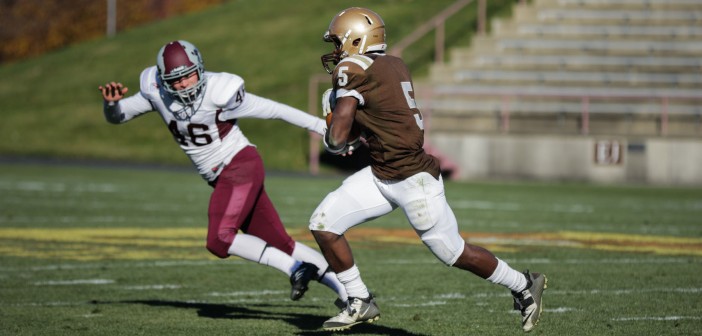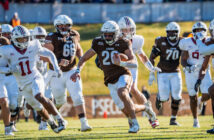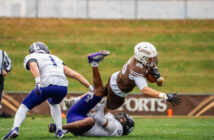In 2013, University of Alabama football coach Nick Saban addressed the fans of the team in a letter after a large portion of the student section continued to leave before the end of the games. According to Saban, thousands of students were leaving the games early despite the team being ranked No. 1 in the country week after week. Still, in 2014, Alabama’s average overall home attendance was more than 98,000 people.
Alabama is struggling to get students to stay for all four quarters. Lehigh, though, has a problem getting students to even show up.
In Lehigh’s five home football games last year, there was a combined student attendance of just 2,721. More than half of that total came in the team’s home opener against James Madison University. Against Colgate University, the team’s only home win of the entire season, only 126 students swiped into the game.
In 2012, the last year where Lehigh football didn’t have a home game against Lafayette, the average student attendance was 964. In 2014, the average attendance for students at a game was just 544.
(Click quote to play audio)“Obviously there’s room for improvement because we’re not selling out,” said Rich Haas, assistant athletic director of sales and marketing. “It’s visible, it’s one of those things that you can see…you can literally see how much room for improvement there is.”
The 2014 season wasn’t even the lowest season for attendance for Lehigh students in recent years. In 2011, taking out the team’s home game against Lafayette, only an average of 533 students swiped into a home game. The highest individual game for student attendance in 2011, with the exception of the Lafayette game, was 722 students against College of the Holy Cross.
Student attendance hasn’t always been this low. According to data from the 2008 season, which recorded the number of total Lehigh IDs swiped (students and faculty), the team had two separate home games not against Lafayette where more than 3,000 students and faculty attended. Haas said that as an estimate, about 75 percent of that number would be students.
So take, for example, the team’s game against Cornell University that year: The total amount of swipes was 3,277. If 75 percent of this number was students, that’s 2,458 at the game — a number which is nearly as high as the total student attendance from the whole 2014 season.
‘Wake up. Drank.’
According to Haas, though there are a wide range of factors that affect the student attendance for football games at Lehigh, tailgating and mocos, the Lehigh-dubbed morning cocktails ritual, is a big one.
“We get a lot of students that come 98 percent of the way to the game and don’t ever make it in the stadium, so that’s a bit frustrating,” Haas said.
Football coach Andy Coen said he believes the drinking culture and tailgate scene greatly affect how many students get through the turnstiles for a game.
(Click quote to play audio)“I think attendance has dropped down,” Coen said. “And not so much in the 10 years that I’ve been here as a head coach. I think every year, for the most part, it’s been fairly consistent. I think the campus is different socially now than it was before.”
Mocos, a pre-game ritual that began around 2008, also encourages students to wear bright neon colors or other strange clothing to games instead of the team’s colors.
For junior offensive lineman Steve Camasta, the mocos custom takes away from support for the actual team.
(Click quote to play audio)“I just think that a lot of students just use our football games as an excuse to day drink and do mocos, but then they don’t even show up to the game,” Camasta said. “And also they never wear brown and white, which is something that also really bothers me.”
In conjunction with mocos, students participate in tailgates located on a series of fields behind the stadium. Fraternities who want to host a tailgate are required to register a space beforehand with the Office of Fraternity and Sorority Affairs.
In a survey of Lehigh students and young alumni, which received 208 responses, nearly 20 percent said they always go to tailgates but only sometimes attend the games. In contrast, just over 10 percent said they always go to both tailgates and the games. Nearly 40 percent responded that they sometimes attend tailgates and sometimes the games.
Kasia Kanczewski, ’15, is a student who goes to every Lehigh football game and every mocos — which she believes is a testament that one can enjoy both mocos and the actual game. She said that mocos have been one of her favorite experiences at Lehigh, but that she doesn’t understand people who go to mocos and skip the game.
“I just don’t understand…why would you get up out of bed to go drink for an hour or two and then go back to sleep?” Kanczewski said. “Whereas instead you could drink, have fun, go to the tailgates, have more fun, go to the game, support your team…I don’t know, it’s not rocket science to me.”
In the open-ended question of the survey, some students suggested that serving alcohol at the stadium for anyone old enough would entice them to go to more games. As of now, no alcohol is allowed inside the entire stadium.
Location, location, location
Taylor Stadium, the Lehigh football stadium from 1914-1987, was located at what is now Zoellner Arts Center and Rauch Business Center. Now, Goodman Stadium is located 3.9 miles away from where it used to be.
In the survey, many of the respondents said they’d be more likely to go to the games if the stadium were on Asa Packer campus. While 96.1 percent of people said they’ve been to at least one Lehigh football game, 85.1 percent of students said they’d be more likely to attend games if they were located on Asa Packer campus.
Student attendance at Lehigh football games is something that has been slowly declining over the years, but it’s hard to pinpoint any one reason that has the biggest effect, said Haas.
He mentioned other factors that affect it, such as weather, if someone has friends to go with and the location of the stadium. Haas was quick to point out that there are outliers to many of these factors though, making it hard to determine how much exactly these factors affect the student attendance number.
Haas said how there are many students that are able to make it to the stadium for tailgating, but then don’t end up going into the stadium, proving that the location of the stadium isn’t an issue for them. He did say that the location prevents people from just dropping by who normally wouldn’t go to the games.
Kanczewski, Camasta and sophomore starting quarterback Nick Shafnisky all cited the location of the stadium as what they thought was one of the biggest factors preventing students from coming to games.
(Click quote to play audio)“If it were still where Rauch Business is, if it were still there, you’re walking by on a Saturday morning at 11 a.m., and all mocos happen on East 5th anyways,” Shafnisky said. “It’s what, three yards away from the field? People would just walk over.”
While many students see the location of the stadium as one of the biggest factors, there are many other reasons students selected for why they don’t attend games.
The survey presented students with two questions asking them to choose as many as they liked from a list of factors that would encourage or discourage them, respectively, from attending games.
A solid majority of students (87.6) said they would attend the game if their friends were going. Strong team record was the least-picked option (67.0 percent) among the seven choices given.
As for reasons students would opt out of attending games, school work and other commitments ranked high, with 78.5 percent of students citing this as a factor.
Weather played a role in students’ responses to both questions — bad weather was the No. 1 factor students selected for not wanting to attend a game (84.2 percent), while good weather was the second highest factor drawing students to the stadium (86.6 percent). The least picked option was lack of interest in football at just 18.2 percent.
Camasta, as well as sophomore quarterback Nick Shafnisky, said they notice that many students who go to the games end up leaving before halftime, which leaves them with a much smaller crowd to cheer for them.
Camasta mentioned that it’s a big advantage to the team, especially on defense, when there’s a loud crowd. He said that the noise can give the opposing offense difficulty with communication in key situations.
Shafnisky agreed with Camasta, saying loudness really pumps him and his teammates up during a game.
(Click quote to play audio)“Especially on defense, if you stop a team that’s driving on you on third down and everyone gets in the game, the players, the coaches, the fans, it adds so much more than people even realize,” Shafnisky said.
A national issue
Despite the low attendance numbers, Lehigh still continuously ranks at the top of the Patriot League in attendance. In 20 of the last 24 years, the university has had the highest attendance in football in the league. Other schools in the conference struggle with the same issue.
Coen pointed out that schools such as Colgate, Lafayette and Bucknell University all regularly have low overall attendance. Holy Cross finished first in the league in 2014 with an average attendance of just 6,748 people, while Lehigh finished in second with 6,249 per game.
The problem of declining overall and student attendance is something that is affecting colleges across the nation. According to a study by the Wall Street Journal of about 80 colleges nationwide, over half of them saw a decrease in student attendance over the past few years. This list of schools with a declining student attendance includes many big name football schools, such as Florida State University, University of Michigan and Louisiana State University.
Many of these schools still have large attendance numbers compared to smaller schools, but they have much larger stadiums. Goodman Stadium was built in 1988 with a capacity of 14,000, but has had a capacity of 16,000 since 1989.
Haas said that Lehigh Athletics does a lot to get the students into the games, though, from giveaways and incentives to the Goodman Bus Service. He said the department also does a comprehensive review of sales and attendance each year in each sport, which includes looking at each game and how many tickets were sold, what the attendance was, what tactics they used and how the market responded.
Many students in the open-ended question of the survey said they wished there was better school spirit at games.
For Haas, the bottom line is to just get kids into the stadium in order to show them the in-stadium experience they create.
“If we can create a fun enough environment, if kids are having fun in the stands, maybe the score becomes a little bit irrelevant,” he said. “You just come because you’re going to have a good time.”






Comment policy
Comments posted to The Brown and White website are reviewed by a moderator before being approved. Incendiary speech or harassing language, including comments targeted at individuals, may be deemed unacceptable and not published. Spam and other soliciting will also be declined.
The Brown and White also reserves the right to not publish entirely anonymous comments.